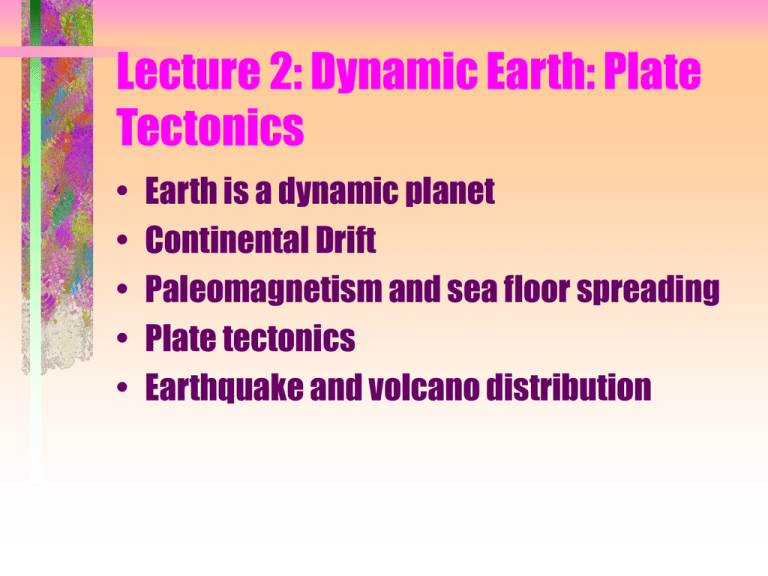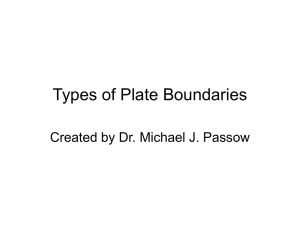Lecture 2: Dynamic Earth: Plate Tectonics
advertisement

Lecture 2: Dynamic Earth: Plate Tectonics • • • • • Earth is a dynamic planet Continental Drift Paleomagnetism and sea floor spreading Plate tectonics Earthquake and volcano distribution Grenoble, France Earth is a dynamic planet The surface of the Earth is constantly changing. Going back a billion years, there were no Grand Canyon, Appalachian Mountains, or Himalayan Mountains. (Thick sedimentary rock accumulated as horizontal layers on an ocean floor are now folded and faulted to from the highest mountains on Earth!) Plate tectonics provides a unifying theory that explains the observed motion of the lithosphere and Earth's major features, such as mountain systems, deep-sea trenches, ocean basins, earthquake belts, and volcano distribution. Greek : tekton --builder tectonics-- the movement & deformation of the lithosphere Continental drift Proposed by Alfred Wegener in 1915: the continents moved about the Earth's surface. Wegener's observations: fit of continents, fossil evidence, rock type and structure. The fit of South America and Africa along the continental slope. Wegener--Continental Drift • This animation presents a view of the continents at the level of map precision available to Alfred Wegener, who proposed that the continents once existed as a vast supercontinent, Pangea, that later fragmented. Test the fit of the continents for yourself by clicking and dragging a continent to a new location; then, using the arrow keys on your keyboard, rotate the continent into position. [by Declan DePaor] • Play Animation Windows version >> • Play Animation Macintosh version >> A distribution of terrestrial (land-based) fossil speices. Note creatures like Mesosaurus could not have swum across the Atlantic. Matching mountain ranges across the North Atlantic. The age and structure of the Appalachian Mountains are comparable to the mountain ranges in the British Isles and Scandinavia. Map of Pangaea, showing distribution of coal, reef, sanddune, and salt deposits. Note how deposits now on different continents align in distinct belts. (American Association of Petroleum Geologists) Paleomagnetism and sea floor spreading Harry Hess put forth seafloor spreading hypothesis in early 1960s, based on paleomagnetic observations. Earth is magnetic, like a magnet. Earth's magnetic field changed polarity with time. Hess's hypothesis: At mid-ocean ridges, rising materials from the mantle spreads laterally. At deep-ocean trenches, the ocean crust is drawn back into the planet. The Earth has a magnetic field. The field resembles that produced by a giant bar magnet placed at the center of the Earth. The reversals of the polarity of Earth’s magnetic field in the recent past. The ocean floor as a magnetic tape recorder. As new basalt is added to the ocean floor at mid-ocean ridges, it is magnetized according to Earth’s existing magnetic field. Ages of the sea floor. The sea floor grows older away from the ridge axis. (W.W. Norton). Seafloor spreading. Molten material of the mantle rises at mid-ocean ridges and spreads laterally; and the deep-ocean trenches are the sites where the ocean crust is drawn back to the mantle. • Plate Tectonics • The theory was put together in late 1960s and early 1970s.The lithosphere is broken into a dozen of rigid blocks "plates", which are moving continuously. • Seven major plates: North American, South American, Pacific, African, Eurasian, Australian-Indian, and Antarctic. A mosaic of rigid plates constitutes Earth’s outer shell. • Plate boundaries There are three basic types of plate boundaries a. Divergent (spreading centers): Plates move away from each other, mostly occurs along ocean ridges. b. Convergent (subduction/collision zones): plates move toward each other, producing ocean trenches, island arcs, mountain ranges. c. Transform fault/margin: Plates slide by each other horizontally, e.g. San Andreas Fault. Schematic representation of plate boundaries A) divergent boundary, B) convergent boundary, and C) transform fault boundary. Zones of plate convergence: A) oceanic-continental, B) oceanicoceanic, C) continentalcontinental. Basic Plate Boundaries Geologists define three types of plate boundary, based simply on the relative motions of the plates on either side of the boundary. These basic types—divergent, convergent, and transform plate boundaries—are shown in the following three-part animation. [by Stephen Marshak] Play Animation Windows version >> Play Animation Macintosh version >> The Mendocino transform fault and the San Andreas Fault. The Mendocino fault connects a divergent boundary (Juan de Fuca ridge) and a convergent boundary (Cascade subduction zone). World active volcanoes. (Smithsonian National Museum of Natural History). Earthquakes and active volcanoes outline plate margins remarkably well. • Earthquake and volcano distribution • The plate margins are outlined remarkably well by earthquakes and active volcanoes. • At divergent margins: shallow earthquakes, submarine volcanoes. • At transform margins: shallow earthquakes, no active volcanoes. • At convergent margins: shallow and deep earthquakes, volcanic eruptions, folded mountain belts. Horizontal velocity map of the Southern California based on geodetic data (mostly GPS). (the Crustal Deformation Working Group of the Southern California Earthquake Center, 1996).











